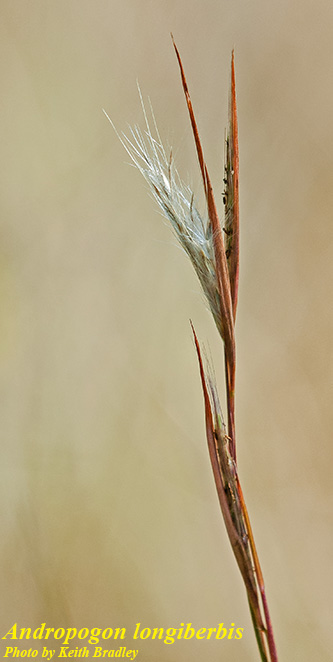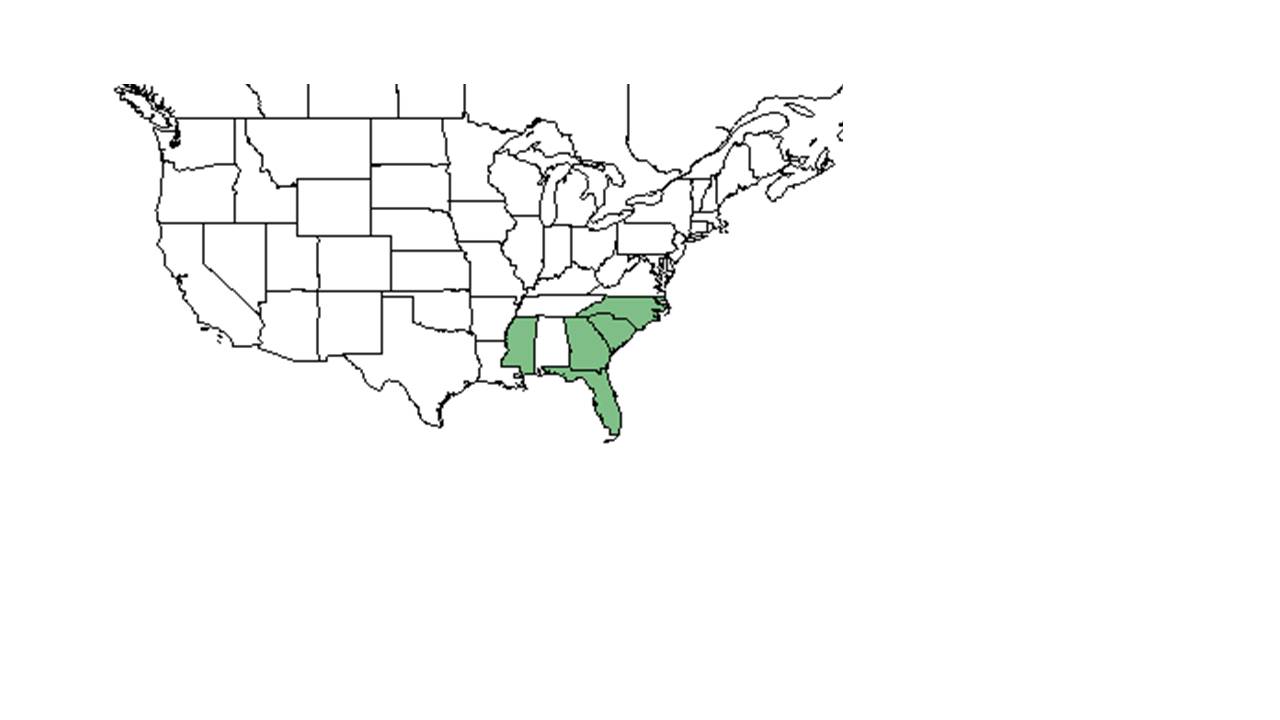Difference between revisions of "Andropogon longiberbis"
(→Distribution) |
|||
| Line 39: | Line 39: | ||
===Phenology===<!--Timing off flowering, fruiting, seed dispersal, and environmental triggers. Cite PanFlora website if appropriate: http://www.gilnelson.com/PanFlora/ --> | ===Phenology===<!--Timing off flowering, fruiting, seed dispersal, and environmental triggers. Cite PanFlora website if appropriate: http://www.gilnelson.com/PanFlora/ --> | ||
It has been seen flowering in April through October<ref>Nelson, G. [http://www.gilnelson.com/ PanFlora]: Plant data for the eastern United States with emphasis on the Southeastern Coastal Plains, Florida, and the Florida Panhandle. www.gilnelson.com/PanFlora/ Accessed: 19 MAY 2021</ref> and fruiting between August to November.<ref name="fsu"/> | It has been seen flowering in April through October<ref>Nelson, G. [http://www.gilnelson.com/ PanFlora]: Plant data for the eastern United States with emphasis on the Southeastern Coastal Plains, Florida, and the Florida Panhandle. www.gilnelson.com/PanFlora/ Accessed: 19 MAY 2021</ref> and fruiting between August to November.<ref name="fsu"/> | ||
| + | |||
| + | In Lake County, Florida, hybridization of ''A. longiberbis'' and ''A. glomeratus var. pumilus'' has been observed.<ref name="campbell">Campbell, C. S. (1982). "Hybridization Between Andropogon glomeratus Var. pumilus and A. longiberbis (Gramineae) in Central Florida." Brittonia 34(2): 146-150.</ref> | ||
<!--===Seed dispersal===--> | <!--===Seed dispersal===--> | ||
<!--===Seed bank and germination===--> | <!--===Seed bank and germination===--> | ||
Revision as of 17:45, 22 June 2021
| Andropogon longiberbis | |
|---|---|

| |
| Photo by Keith Bradley, Atlas of Florida Vascular Plants | |
| Scientific classification | |
| Kingdom: | Plantae |
| Division: | Magnoliophyta - Flowering plants |
| Class: | Liliopsida – Monocotyledons |
| Order: | Poales |
| Family: | Poaceae ⁄ Gramineae |
| Genus: | Andropogon |
| Species: | A. longiberbis |
| Binomial name | |
| Andropogon longiberbis Hack. | |

| |
| Natural range of Andropogon longiberbis from USDA NRCS Plants Database. | |
Common name: Longbeard bluestem
Contents
Taxonomic notes
Synonyms: None.[1]
Varieties: None.[1]
Description
Andropogon longiberbis is a perennial bunch grass whose erect stems grow between 50 - 150 cm tall and are smooth, round, and taper to the ends. The leaf blades exist mostly around the base of the plant stems and are flat and linear, 2 - 10 mm wide and 11 - 50 cm long with pubescence. The terminal inflorescence exist in V-shaped rames of 7 - 97 (usually about 45) per stem. The plant has rhizomes.[2][3]
Distribution
It is found from North Carolina south to southern and western Florida[1] with disjunct populations in the Bahamas.[4]
Ecology
Habitat
Habitats of A. longiberbis include dry, well-drained, sandy soils of longleaf pine-turkey oak sandhills, limerock in pine flatwoods, dunes, wiregrass-palmetto flatwoods, sandy upland old fields, and sand pine-evergreen oak scrubs.[5][1] It grows well in areas of sunlight and semi opened areas and can be found in disturbed habitats such as sandy vacant lots, roadsides, ditches, railroad banks, pine plantations, and waste grounds.
Associated species include Pinus, Quercus, wiregrass, palmetto, turkey oak, Phoebanthus, Psoralia, Schrankia, Smilax auriculata, Helianthemum sp., Cenchrus spinifex, Panicum spp. Heterotheca subaxillaris, Monarda punctata, Quercus hemispherica, and others.[5]
Phenology
It has been seen flowering in April through October[6] and fruiting between August to November.[5]
In Lake County, Florida, hybridization of A. longiberbis and A. glomeratus var. pumilus has been observed.[7]
Conservation, cultivation, and restoration
Cultural use
Photo Gallery
References and notes
- ↑ 1.0 1.1 1.2 1.3 Weakley, A.S. 2015. Flora of the southern and mid-atlantic states. Working Draft of 21 May 2015. University of North Carolina at Chapel Hill, Chapel Hill, North Carolina.
- ↑ [[1]]Encyclopedia of Life. Accessed: March 29, 2016
- ↑ Campbell, C.S. 2021 Flora of North America. Andropogon longiberbis Hack. [[2]].
- ↑ Sorrie, B. A. and A. S. Weakley 2001. Coastal Plain valcular plant endemics: Phytogeographic patterns. Castanea 66: 50-82.
- ↑ 5.0 5.1 5.2 Florida State University Robert K. Godfrey Herbarium database. URL: http://herbarium.bio.fsu.edu. Last accessed: June 2014. Collectors: W. P. Adams, L. C. Anderson, Wm. G. Atwater, R. Blaisdell, C. Campbell, A. F. Clewell, D. S. Correll, F. C. Creager, D. B. Creager, R. K. Godfrey, R. Kral, O. Lakela, W. Lindsey, R. E. Perdue Jr., C. R. Slaughter, and W. R. Stimson. States and Counties: Florida: Alachua, Brevard, Charlotte, Clay, Columbia, Dade, Duval, Franklin, Gilchrist, Hillsborough, Lafayette, Lee, Leon, Levy, Madison, Manatee, Marion, Nassau, Orange, Putnam, St. Johns, Suwannee, Taylor, and Wakulla.
- ↑ Nelson, G. PanFlora: Plant data for the eastern United States with emphasis on the Southeastern Coastal Plains, Florida, and the Florida Panhandle. www.gilnelson.com/PanFlora/ Accessed: 19 MAY 2021
- ↑ Campbell, C. S. (1982). "Hybridization Between Andropogon glomeratus Var. pumilus and A. longiberbis (Gramineae) in Central Florida." Brittonia 34(2): 146-150.